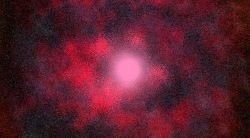 Massive stars like Zeta Puppis are relatively rare, but play a very important role in recycling materials in the Universe. They burn their nuclear fuel much more rapidly than stars like the Sun, living only for millions of years before exploding as a supernova and returning most of their matter to space. But during their brief lives, they lose a significant fraction of their mass through fierce winds of gas driven off their surfaces by the intense light emitted from the star. The fierce wind from a giant star like Zeta Puppis, an extreme blue supergiant, one of the most luminous stars in the Milky Way, 12,500 times more powerful than the Sun, is not a uniform breeze but is fragmented into hundreds of thousands of pieces, according to a study by the ESA’s XMM-Newtonspace observatory.
Massive stars like Zeta Puppis are relatively rare, but play a very important role in recycling materials in the Universe. They burn their nuclear fuel much more rapidly than stars like the Sun, living only for millions of years before exploding as a supernova and returning most of their matter to space. But during their brief lives, they lose a significant fraction of their mass through fierce winds of gas driven off their surfaces by the intense light emitted from the star. The fierce wind from a giant star like Zeta Puppis, an extreme blue supergiant, one of the most luminous stars in the Milky Way, 12,500 times more powerful than the Sun, is not a uniform breeze but is fragmented into hundreds of thousands of pieces, according to a study by the ESA’s XMM-Newtonspace observatory.

